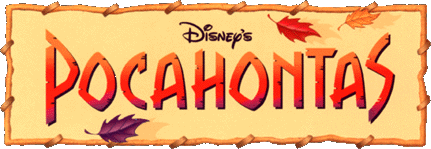
Cast * Interesting Facts * Behind the Scenes * The real Pocahontas

Cast * Interesting Facts * Behind the Scenes * The real Pocahontas
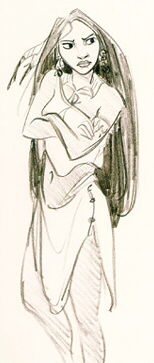 |
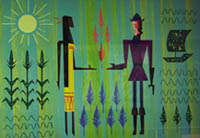 |
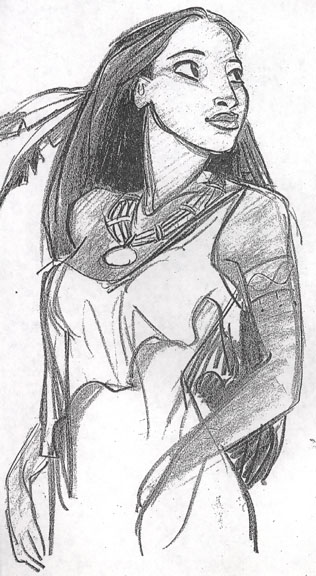 |
Directed by: Mike Gabriel & Eric Goldberg
Written by: Carl Binder & Susannah
Grant
Music by: Alan Menken & Stephen Schwartz
Released on: June 23, 1995
Running Time: 81 minutes
Budget: $55 million
U.S. Opening Weekend: $29.5 million
Box-Office: $142 in the U.S., $347 million
worldwide
CAST

Pocahontas... Irene Bedard (acting)
& Judy Kuhn (singing)
John Smith... Mel Gibson
Grandmother Willow... Linda Hunt
Thomas... Christian Bale
![]() Running
Time: 81 minutes
Running
Time: 81 minutes
![]() Release
Date: June 23, 1995.
Release
Date: June 23, 1995.
![]()

![]() It
is Disney's first animated movie to be based on a true story.
It
is Disney's first animated movie to be based on a true story.
![]() An in-joke, in
which Aladdin's lamp was to have been carefully
placed toward the back of Meeko's den, was cut very early in the production
since the filmmakers insisted that nothing be added to Pocahontas
that could take away from its serious tone.
An in-joke, in
which Aladdin's lamp was to have been carefully
placed toward the back of Meeko's den, was cut very early in the production
since the filmmakers insisted that nothing be added to Pocahontas
that could take away from its serious tone.
![]() The
movie contains quite a few anachronisms: for example, the Union Jack was
not adopted until many years after the film was set. And the Native Americans
didn't plant corn in rows.
The
movie contains quite a few anachronisms: for example, the Union Jack was
not adopted until many years after the film was set. And the Native Americans
didn't plant corn in rows.
![]() When
Pocahontas goes to see Grandmother Willow, she says "Grandmother Willow,
I want to talk to you" but her lips were accidently animated to match "Grandmother
Willow, I want to speak to you".
When
Pocahontas goes to see Grandmother Willow, she says "Grandmother Willow,
I want to talk to you" but her lips were accidently animated to match "Grandmother
Willow, I want to speak to you".
![]() Perhaps
the most notable thing about Pocahontas is the fact that it advances
the art of feature animation further into the area of movie making for
adults.
Perhaps
the most notable thing about Pocahontas is the fact that it advances
the art of feature animation further into the area of movie making for
adults.
![]() The
song "If I Never Know You" got cut from the final film after children in
test audiences found it boring.. An alternative prologue for "Savages"
and songs called "Powerful Magic", "Middle of the River" and "First to
Dance" were also created but not used. Lyricist Stephen Schwartz commented:
"It is very common when one is writing a musical, be it for stage or animated
feature, for songs to be replaced or cut. It's simply part of the developmental
process as one is learning more about the characters and story structure.
My two favorites of the cut songs from
Pocahontas are "In the Middle
of the River", which was to be sung by Pocahontas and John Smith in the
scene before they are discovered together by Kokoum, and "(Someone's Got
to be) The First to Dance", which was to be sung by Grandmother Willow
in more or less the same spot. The decision to cut "If I Never Knew You"
was a mutual one, made more or less unanimously by the creative team after
a couple of previews of the film, where it became clear that the song was
straining the attention span of the younger viewers and slowing the story-telling
to close to the end of the film. I was in favor of cutting it, though I
am not sorry it has been restored for the DVD version, where the need for
story-telling speed is less severe."
The
song "If I Never Know You" got cut from the final film after children in
test audiences found it boring.. An alternative prologue for "Savages"
and songs called "Powerful Magic", "Middle of the River" and "First to
Dance" were also created but not used. Lyricist Stephen Schwartz commented:
"It is very common when one is writing a musical, be it for stage or animated
feature, for songs to be replaced or cut. It's simply part of the developmental
process as one is learning more about the characters and story structure.
My two favorites of the cut songs from
Pocahontas are "In the Middle
of the River", which was to be sung by Pocahontas and John Smith in the
scene before they are discovered together by Kokoum, and "(Someone's Got
to be) The First to Dance", which was to be sung by Grandmother Willow
in more or less the same spot. The decision to cut "If I Never Knew You"
was a mutual one, made more or less unanimously by the creative team after
a couple of previews of the film, where it became clear that the song was
straining the attention span of the younger viewers and slowing the story-telling
to close to the end of the film. I was in favor of cutting it, though I
am not sorry it has been restored for the DVD version, where the need for
story-telling speed is less severe."
![]()
Article written by Jim Hill for the Laughing Place
Pocahontas was happily chugging along the development track at Disney. It was shaping up to be a small but fun film for the studio. Its production team had already decided that the legendary Indian princess should be portrayed as a 12 year-old girl who falls in love with John Smith, a 15 year-old English settler. That seemed like the simplest, most innocent way for the Mouse to handle some fairly sensitive subject material.
But, excited by Beauty & the Beast's Oscar nomination for Best Picture, Jeffrey Katzenberg was reportedly determined to do whatever he had to see to it that another Disney animated film win that award. So Jeffrey scouted out his competition. Looking back over the history of the Oscars, Katzenberg learned that the Academy of Motion Picture Arts and Sciences usually gave its "Best Picture" award to films it felt were big and serious, sweeping romantic epics. Since both Aladdin and The Lion King were too far along in production to get a win-a-Best-Picture-Oscar makeover, Katzenberg pretty much left those films alone. But Jeffrey had plenty of time to shape and mold Pocahontas 'til it was serious enough and important enough that the Academy would *HAVE TO* take notice, guaranteeing Pocahontas a best picture nomination in 1996.
The first thing Katzenberg changed was Pocahontas and John Smith's ages. Now 18 years old, Jeffrey ordered order her animator--animation master Glen Keane--to make Pocahontas "the most beautiful creature that had ever walked the earth." John Smith's age was also moved up, too. No longer a gawky adolescent, Smith was a robust, manly adventurer of 25 years of age. Now that the film's protagonists were adults Katzenberg insisted that Pocahontas and John Smith have an adult romance. This meant passionate kisses in front of large sweeping vistas and meaningful glances against richly detailed backgrounds.
But to make room for all this adult stuff (i.e. Oscar bait), Jeffrey had to cut back on Pocahontas' cute little forest friends. The first to go was a talking turkey, animated by Nik Ranieri, that was supposed to be the Indian princess's confidant. This character, then known as Redfeather, was voiced by John Candy and animated by Nick Ranieri. Redfeather was originally supposed to have provided much of the comic relief for Pocahontas. Candy came into his recording sessions for the film and, in addition to delivering his scripted lines like a pro, improvised a lot of new, funny material for his character right on the spot. Had Redfeather actually survived to make it into the finished film, Pocahontas probably would have been a lot more fun to watch.
But a talking turkey didn't fit into Jeffrey's vision of an Academy Award-winning animated film. No talking animals did. Under Katzenberg's radical revision of the film, Redfeather became Deadfeather--losing his voice in order to be true to nature, before disappearing completely from the film. In his place came Meeko, the non-talking raccoon and Flit, the mostly-silent hummingbird. The irony here is that by trying to create a movie that was sure to win a "Best Picture" nomination, Jeffrey profoundly weakened the finished product. He ended up with an animated film that was too serious for kids yet too lightweight for adults. In the end Pocahontas was an artistic failure--a cartoon that meant well, rather than entertained.
The real tragedy here is that not too long after John Candy's character
got cut from the film John passed away. The heavyset comedian died in his
sleep in March 1994 while on location shooting a comic western in Mexico.
Some of Candy's last work--perhaps his best work--is preserved on those
Redfeather recording sessions for Pocahontas.
![]()
POCAHONTAS'S REAL STORY: How accurate is the Disney adaptation?
Thanks to Nikolette Sorrell for helping me correct this section!
![]() Matoaka
(1595-1617) was the beautiful and lively daughter of Powhatan, ruler of
the land that the English named Virginia. "Pocahontas" was her childhood
nickname, translated as "little wanton," which is a short way to say, "child
whom you can never find because she's out playing somewhere." Pocahontas
may have helped saved the struggling
Matoaka
(1595-1617) was the beautiful and lively daughter of Powhatan, ruler of
the land that the English named Virginia. "Pocahontas" was her childhood
nickname, translated as "little wanton," which is a short way to say, "child
whom you can never find because she's out playing somewhere." Pocahontas
may have helped saved the struggling  Jamestown
colony from extinction twice. The first time (Dec. 29, 1607) is the famous
story that is retold in the Disney movie, wherein she saves the life of
John Smith from execution by Powhatan, her father.
Jamestown
colony from extinction twice. The first time (Dec. 29, 1607) is the famous
story that is retold in the Disney movie, wherein she saves the life of
John Smith from execution by Powhatan, her father.
![]() The
second time (Apr. 24?, 1614) was when she married colonist John Rolfe.
In 1613, at the
The
second time (Apr. 24?, 1614) was when she married colonist John Rolfe.
In 1613, at the
instigation of Captain Samuel Argall, Pocahontas
was kidnapped by a Native American chief named Japazaws and used as a bargaining
chip to secure the release of British soldiers being held prisoner by her
father. Powhatan released seven hostages but his abducted daughter was
still not returned. During her captivity, leading colonists worked
to convert her to Christianity. One of those colonists, John
Rolfe, fell in love with her, and she with him. Pocahontas married
John Rolfe, accepted Christianity, and was baptised "Lady Rebecca Rolfe".
This created several years of peace between the Jamestown colonists and
Powhatan's tribes.
![]() In
the spring of 1616, Rolfe, his wife and their young son, Thomas, left for
England where the Virginia Company was anxious to use her to attract investors
for their New World ventures. Pocahontas became a huge sensation and was
presented at the court of King James and to English society. This part
of her life is covered in the new Disney video, Pocahontas II: Journey
to a New World. At one social gathering, she was reunited with
John Smith after an absence of seven years. She had apparently been told
that he was dead and was shocked to see him. In the early spring of 1617,
the Rolfe family set off for Virginia, but got no further than the English
seaport of Gravesend when she was stricken with smallpox and suddenly died
at the age of 21. Her final resting place is at St. George's Church at
Gravesend.
In
the spring of 1616, Rolfe, his wife and their young son, Thomas, left for
England where the Virginia Company was anxious to use her to attract investors
for their New World ventures. Pocahontas became a huge sensation and was
presented at the court of King James and to English society. This part
of her life is covered in the new Disney video, Pocahontas II: Journey
to a New World. At one social gathering, she was reunited with
John Smith after an absence of seven years. She had apparently been told
that he was dead and was shocked to see him. In the early spring of 1617,
the Rolfe family set off for Virginia, but got no further than the English
seaport of Gravesend when she was stricken with smallpox and suddenly died
at the age of 21. Her final resting place is at St. George's Church at
Gravesend.

![]() The
Disney Movie, "Pocahontas", is accurate in some respects. It captures the
spirit of the woman Pocahontas and her people, and the spirit of the early
days of Jamestown. The settings are accurate: both Jamestown and Powhatan
village are portrayed authentically, according to current historical and
archaeological knowledge. So are London, the American wilderness, and the
ship Susan Constant. John Ratcliffe was in charge of the colony when John
Smith was captured and released by Powhatan. And last but not least, John
Smith wrote that he was saved from execution by Powhatan, when Pocahontas
threw herself between Smith's head and her father's stone club.
The
Disney Movie, "Pocahontas", is accurate in some respects. It captures the
spirit of the woman Pocahontas and her people, and the spirit of the early
days of Jamestown. The settings are accurate: both Jamestown and Powhatan
village are portrayed authentically, according to current historical and
archaeological knowledge. So are London, the American wilderness, and the
ship Susan Constant. John Ratcliffe was in charge of the colony when John
Smith was captured and released by Powhatan. And last but not least, John
Smith wrote that he was saved from execution by Powhatan, when Pocahontas
threw herself between Smith's head and her father's stone club.
![]() However,
the rest of the movie is pure fiction:
However,
the rest of the movie is pure fiction:
1- The physical appearance of Pocahontas and John Smith in the movie are fabricated to please modern tastes. John Smith was a short man who wore a beard. Pocahontas was only a girl of twelve (or younger) when she met the veteran adventurer.
 2-
It is uncertain whether John Smith was telling the truth when he wrote
the story of the rescue. To top that, the movie changed all the details.
Smith was not out alone, or at night, or to meet anyone. The execution
ceremony was not outdoors, and the colony made no attempt to rescue him.
2-
It is uncertain whether John Smith was telling the truth when he wrote
the story of the rescue. To top that, the movie changed all the details.
Smith was not out alone, or at night, or to meet anyone. The execution
ceremony was not outdoors, and the colony made no attempt to rescue him.
3- Ratcliffe was not in charge of the ships on the way over, he was not in charge of the colony at first, and he was never Governor. Ratcliffe was the second President of the colony, elected after President Wingfield was arrested and deposed. Admiral Newport was in charge of the ships, and also took charge of the colony from time to time. Smith favored force, while Ratcliffe favored conciliation.
4- The friends of Pocahontas and John Smith are fictional, of course, although some of the names are taken from real life.
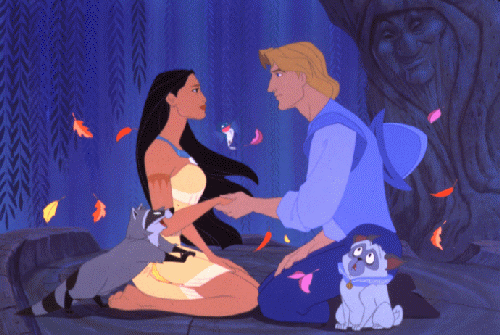 5-
Pocahontas may have had a girlish crush on John Smith, but the man she
married was John Rolfe. When John Rolfe and his wife, Sarah, sailed to
Jamestown, they were shipwrecked in Bermuda by a terrible storm.
John Rolfe fell in love with Pocahontas, and obtained permission from her
father, Powhatan, and the Governor to marry. They had a child, Thomas Rolfe,
whom they brought to England with them. When Pocahontas died on the way
back, Thomas was left behind to be raised by relatives. John Rolfe died
in Virginia during an uprising by Native Americans.
5-
Pocahontas may have had a girlish crush on John Smith, but the man she
married was John Rolfe. When John Rolfe and his wife, Sarah, sailed to
Jamestown, they were shipwrecked in Bermuda by a terrible storm.
John Rolfe fell in love with Pocahontas, and obtained permission from her
father, Powhatan, and the Governor to marry. They had a child, Thomas Rolfe,
whom they brought to England with them. When Pocahontas died on the way
back, Thomas was left behind to be raised by relatives. John Rolfe died
in Virginia during an uprising by Native Americans.
|
||||||||||||